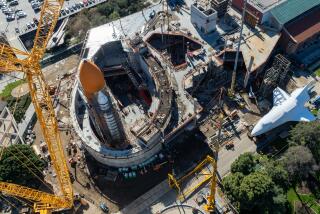Shuttle Mission to Fix Hubble Telescope Is a Hazy, Far-Off Object
- Share via
MELVILLE, N.Y. — Although the space shuttle’s Tuesday touchdown eased some of NASA’s worst fears, the problems that led to an indefinitely grounded shuttle fleet have only ratcheted up the anxiety of researchers over the fate of the Hubble Space Telescope.
The Greyhound bus-sized telescope, launched in 1990 after a lengthy delay following the Challenger shuttle disaster, has been praised by Stony Brook University professor Ken Lanzetta as “pretty much the best thing that has ever happened to astronomy.”
But Hubble’s future is dependent on a shuttle mission to repair the failing gyroscopes that keep it oriented in space, and to replace the batteries that keep its most crucial instruments warm. But before the space agency can heal its ailing patient, it must first fix the celestial ambulance that would deliver the means to do so.
Over its lifetime, the telescope has captured an estimated 750,000 images -- an impressive photo album full of exotic galaxies, nebula and other celestial objects.
Richard Berendzen, a professor of physics at American University, said the Hubble also had captured a wealth of data on the fundamental nature of the universe, proving its scientific value “far more than anyone has ever expected.”
Losing the telescope, he said, would be “like losing a friend.”
During the Hubble’s last upgrade, in 2002, astronauts on the shuttle Columbia installed the telephone booth-sized Advanced Camera for Surveys, improving the resolution of the telescope’s images tenfold.
For the last of the servicing missions, initially planned for next year, NASA astronauts would have boosted Hubble into a higher orbit, installed new batteries and replaced two broken gyroscopes. New instruments would have detected the composition of interstellar gas and expanded Hubble’s view in both infrared and ultraviolet wavelengths.
But former NASA Administrator Sean O’Keefe pulled the plug on the mission over safety concerns after the Feb. 1, 2003, Columbia accident, and the White House reportedly balked at an estimated Hubble rescue mission price tag of $1 billion or more.
Preston Burch, NASA’s Hubble Space Telescope program manager, said that without repairs, the failing gyroscopes would bring the telescope’s science to a halt about mid-2008. The batteries keeping Hubble’s most crucial parts warm are expected to last well into 2010, but “a couple of days without power will spell the end of Hubble’s life,” Burch said. After that, the telescope would be little more than a dead metallic moon, expected to stay in orbit around the Earth until at least 2021.
During his April confirmation hearing, new NASA Administrator Michael D. Griffin promised to reconsider a rescue mission.
Tammy Smecker-Hane, an astrophysicist at UC Irvine, said she was worried but still optimistic that NASA could “repair the best observatory we’ve ever had.”
“There’s so much work that still needs to be done, which is why it would be just such a shame if this telescope dies early,” she said, listing a set of questions that continued to baffle researchers. What is dark matter, the mysterious stuff that may comprise much of the universe? Why is the universe expanding at a faster rate? And how do galaxies evolve over time?
In a best-case scenario, Burch said, the rescue mission would come no sooner than the end of 2007.
The James Webb Space Telescope, Hubble’s successor, won’t launch until 2011.






